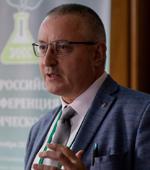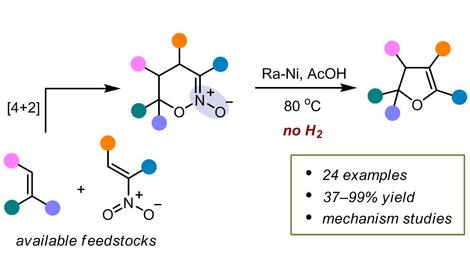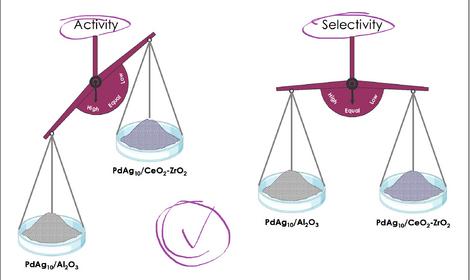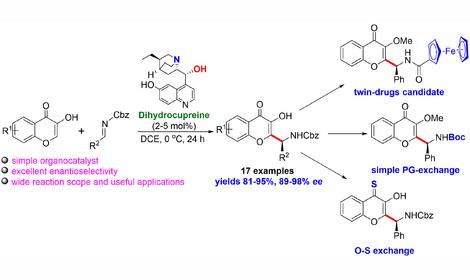Laboratory of supramolecular chemistry (№2)

Telegram-chanel: t.me/supra_szv
ORCID: 0000-0001-7884-8579
Researcher ID: D-4721-2013
h-index = 21 (Scopus: 6701846497)
Design, synthesis, and study of new molecules as components of functional supramolecular ensembles and materials based on them, as well as the application of supramolecular approaches in organic chemistry, medical chemistry, and organic materials science:
- synthesis of polydentate polyheterocyclic, macrocyclic, and macropolycyclic compounds, including chiral ones, as selective receptors and catalysts;
- detailed study of the interaction of synthetic and natural molecules with natural and synthetic receptors using experimental and theoretical methods;
- research on the fundamental role of weak interactions in the study of intermolecular contacts and mechanisms of organic reactions, including catalytic reactions;
- design and application to the study of the reaction mechanisms of catalysts labeled with radical and luminescent tags;
- study of stereoelectronic effects using computational and experimental methods;
- creation of bioimaging tools using lanthanide complexes and luminescent organic molecules and photophysical materials based on them;
- development of selective delivery systems and controlled release of pharmaceuticals and agrochemicals;
- creation of radiopharmaceuticals based on metal complexes conjugated with vector modules for selective delivery and diagnostics;
- synthesis and study of supramolecular polymers, including gels and metallogels, coordination polymers, metal-organic frameworks, supramolecular organic frameworks, and covalent organic frameworks; study of the photochemical, sorption, catalytic, and magnetic properties of the resulting new materials.
✓ A new family of amphiphilic molecules
A novel homologous series of amphiphilic bispidine derivatives, 1-alkyl-1,3-diazaadamantan-1-azonia bromides (CnAD, where n = 10, 12, 14, 16, 18), was synthesized, and their structure was characterized by X-ray diffraction, 13C and 1H NMR-spectroscopy. The Krafft point of CnAD was determined using conductometry. In homologous series, the critical micelle concentration (cmс) decreases from 7.9 mM to 2.7 mM as the tail length increases from the decyl to the tetradecyl homologue, with a high correlation coefficient (R² = 0.98). Spectrophotometry was employed to confirm the aggregation thresholds of these amphiphiles and to determine their solubilization capacity toward Orange OT, which ranged from 0.03 to 0.04 molOOT/molCnAD. Turbidimetry and electrophoretic light scattering demonstrated the ability of CnAD to integrate into the lipid bilayer of 1,2-dipalmitoyl-snglycero-3-phosphocholine. It was established that long-tail homologues exhibited significantly higher antibacterial activity compared to the reference drugs chloramphenicol and norfloxacin. Additionally, their ability to influence the integrity of the cell membrane and cell wall of S. aureus, as well as to change its membrane potential, was assessed. Hemotoxicity assays revealed that C14AD possesses selective antimicrobial activity.
Amphiphilic 1-alkyl-1,3-diazaadamantan-1-azonia bromides: A journey into self-organization and interaction with the lipid bilayer Journal of Molecular Structure. – 2026. – V. 1351. – 144157. DOI: 10.1016/j.molstruc.2025.144157
✓ Overview of modern concepts of cocktail catalysis.
This review explores the concept of cocktail-type catalysis, a dynamic framework that extends the traditional binary distinction between homogeneous and heterogeneous catalytic systems. It emphasizes the coexistence and continuous transformation of multiple catalytically active species, highlighting cocktail catalysis as a flexible and adaptable system. The discussion is grounded in selected examples, particularly palladium- and other metal-mediated reactions, where experimental evidence indicates a complex interplay of distinct catalytic forms. Key mechanistic insights are drawn from in situ and operando techniques, revealing the dynamic nature of catalytic centers and the implications for reaction efficiency, selectivity, and catalyst recyclability. The review also addresses the challenges of mechanistic uncertainty, the role of catalyst evolution, and the significance of characterizing active species under real reaction conditions. Applications in cross-coupling, C–H functionalization, hydrosilylation, and hydrogenation demonstrate the practical relevance of this concept. Finally, the review highlights the potential of cocktail-type catalysis to inform the development of more adaptive and sustainable catalytic systems, particularly in the context of green chemistry and industrial scalability. Rather than offering definitive generalizations, this review aims to contribute to open a discussion and to search for a broader mechanistic understanding of catalysis as a multifaceted process.
Cocktail-type Catalysis – An Emerging Concept in Metal-Mediated Transformations // Organometallics 2025 V. 44. Is. 13. P. 1337-1357 DOI: 10.1021/acs.organomet.5c00117 (Q1)
✓ New anti-cancer molecules based on ruthenium complexes.
The search for new anticancer drugs is still a very important task for modern chemistry. Some of the most intensively studied objects are metal complexes, in particular complexes of platinum, ruthenium, iridium and osmium. To address this issue, novel organometallic ruthenium complexes with thiophene-based imines containing a Ru-C bond were synthesized and tested against cancer cell lines. The scaffold is designed to allow the generation of a broad library of cyclometallated compounds from commercially available substrates. Compounds were characterized using spectroscopic, electrochemical, and X-ray diffraction techniques. They were found to have a very good cytotoxicity among ruthenium complexes against A2780, A549 and MCF-7 cancer cells and against HEK cells.
Cycloruthenated thiophene-imines: novel anticancer agents // J. Organomet. Chem, 2025, Vol. 1038, 123726 DOI: 10.1016/j.jorganchem.2025.123726
✓ New conjugates of bispedins and biological vectors for radiopharmaceuticals.
Nowadays, PSMA ligands are widely used for radiotheragnostic purposes in prostate cancer. The synthesis of a PSMA-Bisp conjugate was developed and realized with good yield (overall yield ~58% for the last two steps). All newly synthesized compounds were characterized by physicochemical methods: 1H and 13C NMR, HRMS, and LCMS (for biologically tested samples). Subsequently, Bisp1 (diacetate bispidine ligand), Bisp-alkyne (bifunctional derivative of Bisp1), and its conjugate PSMA-Bisp were labeled by 64Cu in mild conditions. In vitro studies of the labeled conjugate [64Cu]Cu-PSMA-Bisp have shown great stability in model solutions. Finally, [64Cu]Cu-PSMA-Bisp was compared to the well-known PSMA-617 conjugate labeled with 64Cu and they showed similar stability in excess bovine serum (BVS), and at the same time, labeling PSMA-Bisp with 64Cu is characterized by extremely high kinetics in mild conditions, while labeling PSMA-617 with 64Cu requires heating (90 °C). Thus, this conjugate can be incredibly promising for nuclear medicine.
Synthesis of bispidine based PSMA targeted conjugate and initial investigations // Organics, 2025, V. 6. Is. 1, P. 7-23. DOI: 10.3390/org6010007
✓ A new supramolecular tecton
A new tricationic organic supramolecular tecton has been designed and synthesized. Contrary to known mono- and dicationic species, this new molecule, being a “three-way connector”, allows assembling infinite supramolecular sheets and nets upon interaction with appropriate inorganic counterpart complex anions. In this work, triprotonated 6-amino-5,7-dimethyl-1,3-diazaadamantane, comprising two secondary and one primary nitrogen atoms, is used as a trication to form hybrid compounds with iodometallate anions by forming five hydrogen bonds at a time. It is shown that the bulky cation works simultaneously as a spacer and a connector, such that the positions of inorganic [MI6]3− anions (M = Sb or Bi) in the crystal structures are defined by five hydrogen bonds and are well-separated from each other. The latter is considered as a prerequisite for the hybrid compounds to exhibit optical properties originating from the undisturbed electronic structure of individual inorganic anions.
A new supramolecular tecton: the crucial impact of the polycation charge and geometry of H-bonds on the structure and properties of halometallates in the solid state // Dalton Transactions, 2025, V. 54, Is. 17, P. 6983-6992. DOI: 10.1039/D5DT00318K
✓ New information about the role of organocatalysts
The aim of this work was the investigation of novel organocatalysts for the Michael addition of diethyl malonate to β-nitrostyrene. The methodology of the study included NMR titration, reaction monitoring by NMR spectroscopy and electrospray ionization mass spectrometry (ESI-MS), product characterization by MALDI, IR spectroscopy, scanning electron microscopy (SEM), thermal gravimetric analysis (TGA), and elemental analysis. As a result, evidence of supramolecular interactions between two pairs of components of the reaction was found. In addition to the supramolecular complexes, an unusual reaction, i.e., the Michael addition of NH-bispidines to β-nitrostyrene, was found, which led to previously unknown oligomers of β-nitrostyrene. A new mechanism for the catalytic action of NH-bispidine was proposed, which involved catalysis not by the initial organocatalyst but rather by its adduct with β-nitrostyrene. Thus, in this reaction, N-benzylbispidine acted as an initiator, and the real catalyst was the betaine formed during the initiation stage.
Reaction of β-Nitrostyrene with Diethyl Malonate in the Presence of Bispidines: The Unusual Role of the Organocatalyst // Chemistry. 2024. V. 6. No. 3. P. 387–406. DOI: 10.3390/chemistry6030023
✓ A possibility of manifestation of the anomeric effect of the sp-hybridized carbon atom, which is a component of triple C≡C and C≡N bonds, was studied. The effect of carbon hybridization on the acceptor capacity of the carbon—carbon σ-bonds was evaluated. A high effective electronegativity of the sp-hybridized carbon atom was found to exert a noticeable effect on the magnitude of the anomeric interactions . The triple bond in such systems indeed can participate in anomeric interactions, which was proved for N-propargyl substituted bispidines as an example using experimental (XRD) and computational methods. This participation is expressed in the stabilization of the bisectral conformation of the N—CH2—C≡CH and N—CH2—C≡N fragments in the case of N-monosubstituted and N,N′-disubstituted bispidines. The values of charge transfer from an unshared pair of nitrogen atoms to the σ-antibonding orbital of the C≡C—CH2 bond calculated for the model Me2N—CH2—X systems by the NBO method are up to 11.0 kcal mol−1, which is relatively low for the classical anomeric effect: the corresponding value for the N≡C—CH2 fragment is 11.3 kcal mol−1. The anomeric effect manifested by the acetylene group makes it possible to stabilize certain conformations in the bispidine systems containing propargyl substituents, which can affect the reactivity of acetylenes. For the N-benzyl systems (9.4 kcal mol−1) and N-allyl (9.4 kcal mol−1) and N-propyl (10.0 kcal mol−1) derivatives, the hyperconjugation stabilization is weaker and does not play a decisive role in conformational equilibrium. The obtained data are of obvious interest for specialists working in the field of the chemistry of the triple bond of the propargyl type.
Not all carbon—carbon bonds are equivalent: anomeric effect of sp-hybridized carbon atom // Russ. Chem. Bull. – 2024. – V. 73. – P. 363–371. DOI: 10.1007/s11172-024-4143-8.
✓ Hydrogen peroxide as a halogen bond acceptor
The halogen bonding in molecular crystals and supramolecular assemblies has been widely investigated. Special attention is given to the molecular structures capable of simultaneously exhibiting different types of non-covalent interactions, including conventional hydrogen bonds and halogen bonds. This paper systematically analyzes crystalline peroxosolvates of bispidine-based bis-amide derivatives, containing haloacetic acid residues, namely previously reported 1,1′-(1,5-dimethyl-3,7-diazabicyclo[3.3.1]nonane-3,7-diyl)bis(2-iodooethanone) peroxosolvate C13H20I2N2O2·H2O2 (1) and four new crystalline compounds, 1,1′-(1,5-dimethyl-3,7-diazabicyclo[3.3.1]nonane-3,7-diyl)bis(2-bromoethanone) peroxosolvate C13H20Br2N2O2·H2O2 (2), 1,1′-(9-hydroperoxy-9-hydroxy-1,5-dimethyl-3,7-diazabicyclo[3.3.1]nonane-3,7-diyl)bis(2-iodoethanone) peroxosolvate C13H20I2N2O5·0.5H2O2 (3), 1,1′-(9-hydroperoxy-9-hydroxy-1,5-dimethyl-3,7-diazabicyclo[3.3.1]nonane-3,7-diyl)bis(2-bromoethanone) peroxosolvate C13H20Br2N2O5·H2O2 (4), and 1,1′-(9-hydroperoxy-9-hydroxy-1,5-dimethyl-3,7-diazabicyclo[3.3.1]nonane-3,7-diyl)bis(2-chloroethanone) peroxosolvate C13H20Cl2N2O5·H2O2 (5). Compounds 2–5 were synthesized for the first time and their crystal structures were determined by single-crystal X-ray diffractometry (SCXRD). To the best of our knowledge, 3–5 are unprecedented crystalline hydrogen peroxide adducts of organic hydroperoxides (R-OOH). Short intermolecular contacts between halogen and hydroperoxo oxygen atoms were found in 1–3. The halogen bonding of C–I(Br) fragments with dioxygen species in compounds 1–3 as well as in the previously reported cocrystal of diacetone diperoxide with triodotrinitrobenzene (6) was identified through reduced density gradient analysis, Hirshfeld surface analysis, and Bader analysis of crystalline electron density. The interactions were quantified using the electron density topological properties acquired from the periodic DFT calculations and evaluated to lie in the range of 9–19 kJ mol−1. A distinctive spectral feature was revealed for this type of interaction, involving a red shift of the characteristic O–O stretching vibration by about 6 cm−1, which appeared in IR spectra as a narrow low-intensity band in the region 837–872 cm−1.
Dioxygen–halogen bonding exemplified by crystalline peroxosolvates of N,N′-bis(haloacetyl) bispidines // Phys Chem Chem Phys, 2024, vol. 26, pp. 5195-5206 DOI: 10.1039/D3CP05834D












